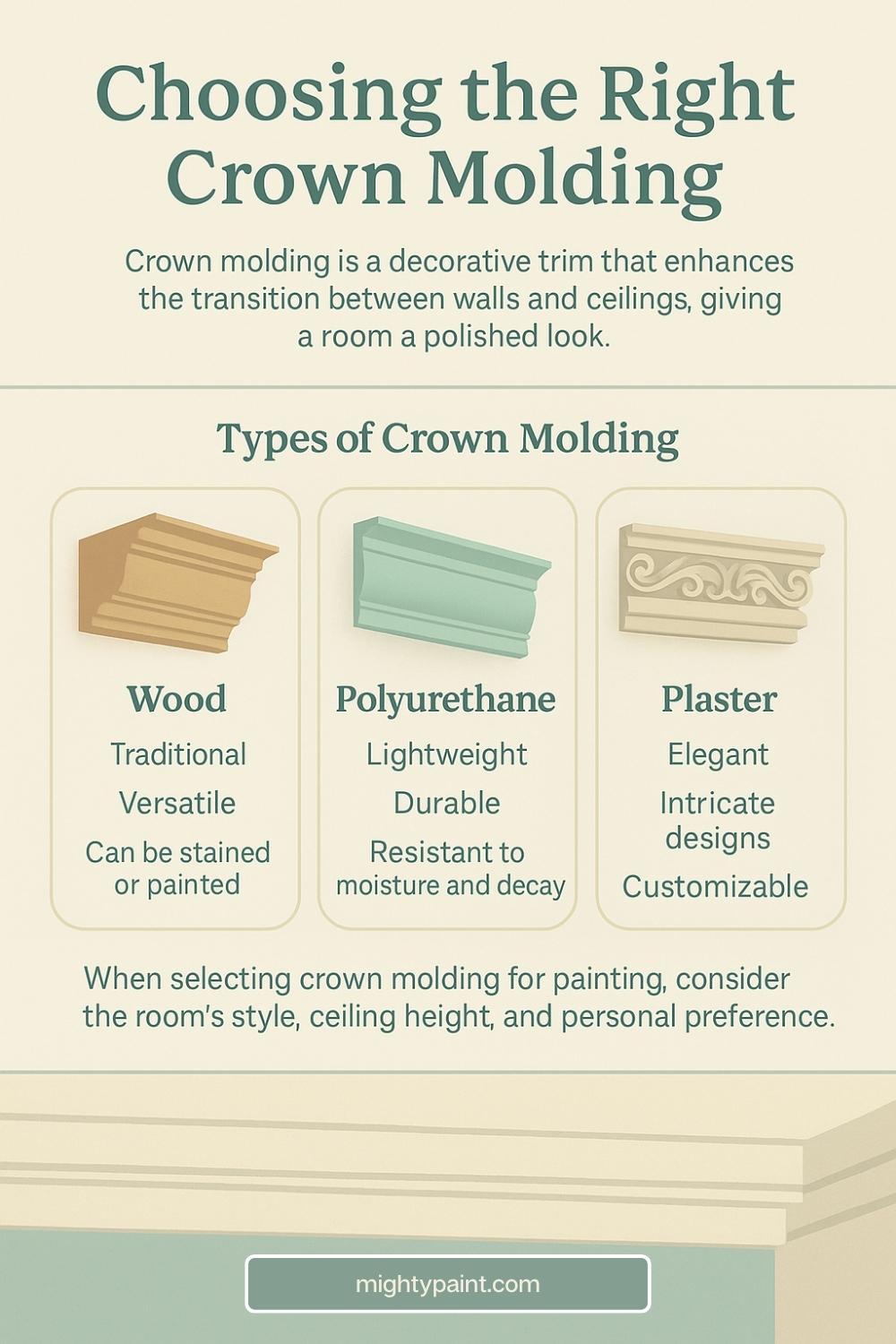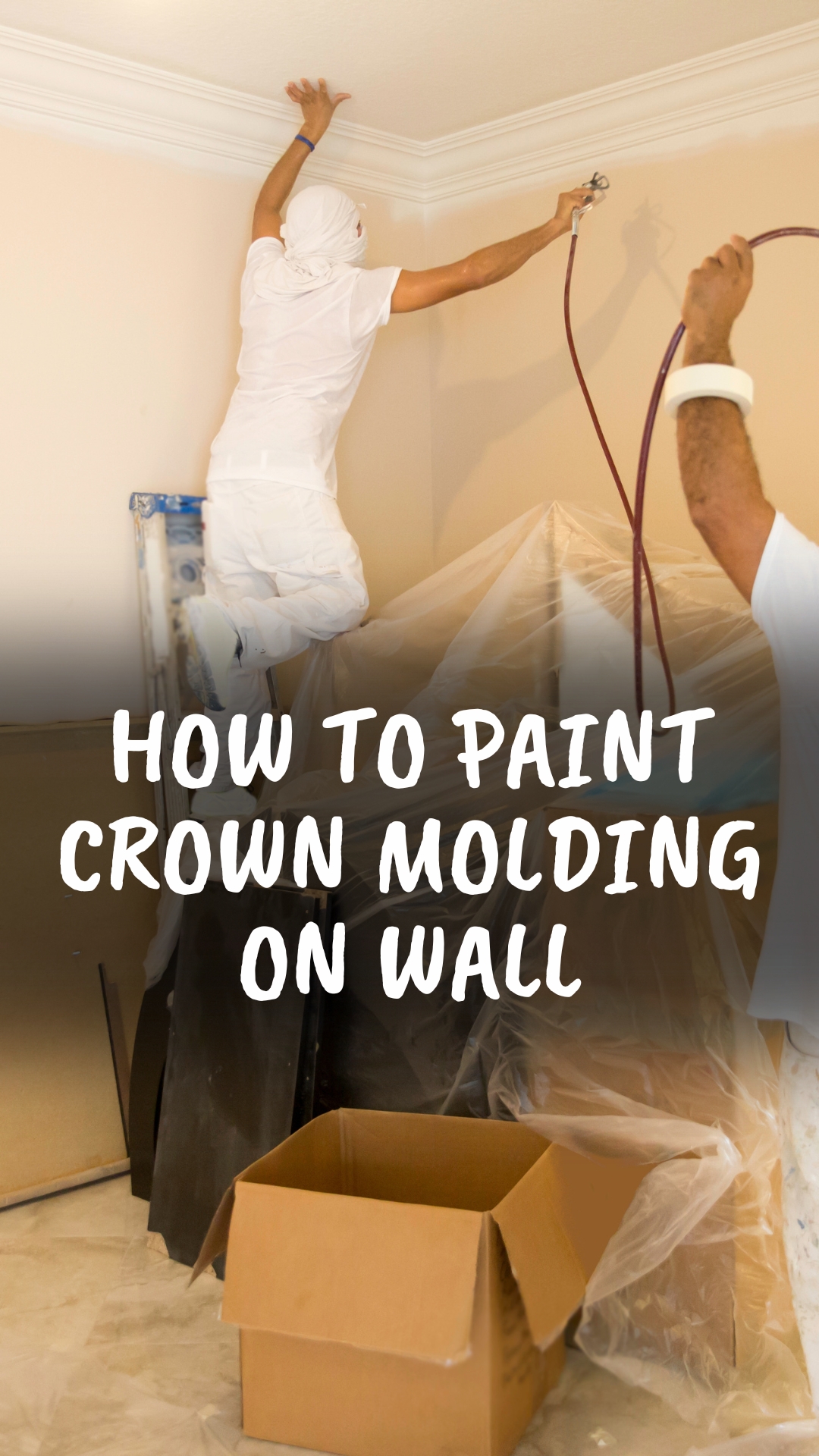How to Paint Crown Molding on Wall: Quick and Easy Tips
Painting crown molding can seem tricky, but it doesn’t have to be. Imagine bringing your room to life with just a few strokes. Many people find this task intimidating despite its simplicity. For a clean and professional finish, always keep a wet edge and apply two thin coats of paint.

You don’t need to be a pro to get stunning results. With just a little guidance and patience, your crown molding can look amazing. Ever tried using an airless sprayer? It’s a game-changer for those seeking efficiency and smooth results. Plus, you can even avoid that pesky ladder!
Get the Fail-Safe Paint Color Playbook (Free PDF)
36 proven colors • 8 ready palettes • trim & sheen guide • printable testing cards.
Ready to give your walls the facelift they deserve? Grab your brush, a can of paint, and let’s dive into making your crown molding the envy of every visitor. With just four simple steps, you’ll be on your way to a room that truly shines.
Understanding Crown Molding and Its Types
Crown molding is a decorative trim that enhances the transition between walls and ceilings, giving a room a polished look. Before you embark on painting your crown molding, it’s crucial to understand its types and select the appropriate molding for your space.

Types of Crown Molding
Crown molding comes in various materials and styles, allowing you to choose the one that suits your design preferences and complements the room’s overall aesthetic. Let’s explore some popular types of crown molding:
| Material | Attributes |
|---|---|
| Wood | Traditional, versatile, can be stained or painted |
| Polyurethane | Lightweight, durable, resistant to moisture and decay |
| Plaster | Elegant, intricate designs, customizable |
When selecting crown molding for painting, consider factors such as the room’s style, ceiling height, and personal preference. The chosen material should be suitable for painting and offer a smooth surface for achieving a flawless finish.
Now that you have a good understanding of crown molding, let’s move on to preparing the molding and the surrounding area.
Preparing the Crown Molding and the Surrounding Area
Before you start painting your crown molding, it’s important to prepare both the molding itself and the surrounding area to ensure a clean and efficient painting process.
Cleaning the Crown Molding
To achieve a smooth and even paint application, it’s essential to clean the crown molding thoroughly. Over time, dust, dirt, and grime can accumulate on the surface, affecting paint adhesion and the overall finish.
To clean the crown molding:
- Use a soft cloth or sponge to wipe away any loose dust or debris.
- Prepare a solution of mild dish soap and warm water.
- Dip a clean cloth or sponge into the solution and gently wipe the crown molding, focusing on any areas with visible dirt or stains.
- Rinse the molding with clean water to remove any soap residue.
- Allow the crown molding to dry completely before proceeding to the next steps.
By ensuring the crown molding is clean, you create a suitable surface for paint adhesion and minimize the risk of imperfections.
Protecting the Surrounding Walls and Surfaces
While painting the crown molding, it’s important to protect the surrounding walls, ceiling, and other surfaces from accidental paint splatters or drips. Taking the time to properly mask and cover these areas will save you time and effort during cleanup.
Here are some steps to protect the surrounding areas:
- Apply painter’s tape: Use painter’s tape to create a clean and precise edge between the crown molding and the adjacent surfaces. Ensure the tape is securely adhered, and press it down firmly to prevent paint bleed-through.
- Cover the walls and floor: Use drop cloths or plastic sheeting to cover the walls and the floor beneath the crown molding. This protective layer will catch any paint drips or splatters, preventing damage to the surfaces.
- Remove furniture or cover it: If possible, remove furniture from the area to create more space for painting. If removal is not feasible, cover the furniture with plastic sheeting or old bedsheets to safeguard it from paint splatters.
Taking these precautionary measures will help you maintain a clean and organized workspace, allowing for a smooth painting process.
Now that you have prepared the crown molding and the surrounding area, it’s time to focus on the surface preparation for the molding.
Get the Fail-Safe Paint Color Playbook (Free PDF)
36 proven colors • 8 ready palettes • trim & sheen guide • printable testing cards.
Surface Preparation for Crown Molding
Proper surface preparation is key to achieving a flawless paint finish on crown molding. This step involves inspecting the molding for imperfections and ensuring a smooth surface for paint adhesion.

Inspecting the Crown Molding for Imperfections
Before painting, carefully inspect the crown molding for any cracks, gaps, or dents. These imperfections can affect the overall appearance of the finished paint job. Addressing these issues beforehand will ensure a seamless and professional-looking result.
To inspect the crown molding:
Get the Fail-Safe Paint Color Playbook (Free PDF)
36 proven colors • 8 ready palettes • trim & sheen guide • printable testing cards.
- Examine the molding from various angles and distances to identify any visible imperfections.
- Pay close attention to the joints and corners, as these areas are prone to cracks or gaps.
- Use a flashlight or a focused light source to reveal any hidden flaws.
Repairing and Filling Damages
Once you have identified imperfections in the crown molding, it’s time to repair and fill them. Here’s how:
- Cracks and Gaps:
- Use a putty knife or a flexible filler applicator to gently scrape away loose paint or debris from the cracks or gaps.
- Apply an appropriate wood filler, polyurethane filler, or spackling compound to the damaged area, following the manufacturer’s instructions.
- Smooth the filler using the putty knife, ensuring it is level with the surface of the molding.
- Allow the filler to dry completely and then lightly sand it to create a smooth finish.
- Dents and Dings:
- For minor dents, use a damp cloth to moisten the affected area.
- Apply heat using a hairdryer or a heat gun set to low. Gently heat the dented area while applying pressure with your fingers to reshape it.
- If the dent is more significant, you may need to use a wood filler or epoxy filler to rebuild the damaged portion.
By repairing and filling any damages, you create a seamless surface that will ensure the paint adheres properly and provide a smooth finish. After the repairs, it’s important to sand the crown molding to further prepare the surface for painting.
Sanding the Crown Molding
Sanding the crown molding helps create a smooth and even surface, allowing the paint to adhere properly and minimizing the appearance of imperfections. Follow these steps for effective sanding:
- Choose the appropriate sandpaper grit based on the condition of the molding and the desired smoothness. A medium-grit sandpaper (around 120-150 grit) is usually suitable for most crown moldings.
- Wrap the sandpaper around a sanding block or use a sanding sponge to provide a firm and even surface for sanding.
- Start sanding the molding in a consistent motion, using light to moderate pressure. Sand along the length of the molding, following the wood grain or the molding’s contours.
- Pay extra attention to the repaired areas, ensuring they are blended smoothly with the rest of the molding.
- Periodically check the sandpaper for clogging and replace it if necessary to maintain optimal sanding performance.
- Once you have achieved a smooth and even surface, wipe away any sanding residue using a clean, damp cloth.
By sanding the crown molding, you create a suitable surface for paint adhesion and ensure a polished and flawless finish. The next step is primingthe crown molding to further enhance paint adhesion and promote a professional-looking result.
Priming the Crown Molding
Priming the crown molding is a crucial step in the painting process. It helps create a smooth and uniform surface, improves paint adhesion, and enhances the longevity of the paint job. Let’s explore the steps for priming the crown molding.
Importance of Priming Crown Molding
Priming serves as a base layer between the molding and the paint, providing several benefits:
- Better paint adhesion: Primer creates a porous surface that allows paint to adhere effectively to the crown molding, ensuring a long-lasting finish.
- Improved coverage: Primer helps to even out the surface and enhances paint coverage, especially when transitioning from a dark-colored molding to a lighter paint color.
- Sealing and protecting the molding: Primer seals the surface of the crown molding, preventing the absorption of excessive moisture from the paint, which could cause warping or damage.
- Smoother finish: By filling in minor imperfections and creating a uniform surface, primer helps achieve a smooth and flawless finish.
Choosing the Right Primer
When selecting a primer for your crown molding, consider the material of the molding and the type of paint you will be using. Here are some guidelines for choosing the appropriate primer:
- For wood crown molding: Use a high-quality latex or oil-based primer, specifically formulated for wood surfaces. These primers provide excellent adhesion and help seal the wood to prevent bleeding or tannin stains.
- For polyurethane or plaster crown molding: Opt for a primer suitable for non-porous surfaces. Look for primers designed for smooth surfaces or those specifically recommended for polyurethane or plaster.
Ensure that the primer you choose is compatible with both the molding material and the paint you will be applying. Refer to the manufacturer’s instructions for specific recommendations and drying times.
Get the Fail-Safe Paint Color Playbook (Free PDF)
36 proven colors • 8 ready palettes • trim & sheen guide • printable testing cards.
Applying Primer to the Crown Molding
Now that you have selected the appropriate primer, it’s time to apply it to the crown molding. Follow these steps for effective priming:
- Prepare the work area: Lay down a drop cloth or plastic sheeting to protect the surrounding surfaces from primer spills or drips.
- Stir the primer: Use a stir stick to thoroughly mix the primer, ensuring any settled pigments or additives are evenly distributed.
- Load the brush or roller: Dip a high-quality brush or a small foam roller into the primer, removing any excess by tapping it against the edge of the container or tray.
- Apply the primer: Start at one end of the crown molding and work your way along its length. Apply the primer in smooth and even strokes, following the contours of the molding. Use a brush for intricate details and a roller for larger, flat sections.
- Feather the edges: To ensure a seamless transition between the primed areas and the unpainted sections, feather the edges of the primer by lightly brushing or rolling over them without adding additional primer.
- Allow the primer to dry: Follow the manufacturer’s instructions for drying times. Typically, primers require at least 24 hours to dry thoroughly. Ensure the room is well-ventilated during the drying process.
By applying primer to the crown molding, you create a solid foundation for the paint, ensuring better adhesion and a more professional-looking finish. Once the primer is completely dry, you can proceed to the exciting part—painting the crown molding.
Painting Techniques for Crown Molding
Now that the crown molding has been prepared and primed, it’s time to apply the paint. Proper painting techniques will help you achieve a smooth and professional finish on your crown molding. Let’s explore the best practices for painting crown molding.
Choosing the Right Paint
Selecting the right paint for your crown molding is essential to achieve the desired look and durability. Consider the following factors when choosing paint:
- Paint Type: Opt for a high-quality latex or oil-based paint that is suitable for the material of your crown molding. Latex paints are generally easier to work with, while oil-based paints provide a more durable and glossy finish.
- Finish: Determine the desired sheen for your crown molding. Common options include satin, semi-gloss, or high-gloss finishes. Higher gloss finishes tend to be more resistant to wear and easier to clean, but they may also highlight imperfections.
- Color: Choose a color that complements your room’s decor and desired aesthetic. Consider the overall color scheme and the effect you want the crown molding to have on the space—whether it should blend in or make a statement.

Painting the Crown Molding
Follow these steps to achieve a professional finish while painting your crown molding:
- Prepare the work area: Lay down a drop cloth or plastic sheeting to protect the surrounding surfaces from paint spills or drips.
- Stir the paint: Use a stir stick to thoroughly mix the paint, ensuring any settled pigments or additives are evenly distributed.
- Load the brush or roller: Dip a high-quality brush or a small foam roller into the paint, removing any excess by tapping it against the edge of the container or tray.
- Apply the paint: Start at one end of the crown molding and work your way along its length. Apply the paint in smooth and even strokes, following the contours of the molding. Use a brush for intricate details and a roller for larger, flat sections.
- Feather the edges: To ensure a seamless transition between the painted areas and the unpainted sections, feather the edges of the paint by lightly brushing or rolling over them without adding additional paint.
- Maintain a wet edge: When painting larger sections, such as long runs of crown molding, it’s important to maintain a wet edge. This means working quickly and not allowing the paint to dry completely between strokes. By overlapping the paint slightly, you create a smooth and consistent finish.
- Allow the paint to dry: Follow the manufacturer’s instructions for drying times between coats and before handling. Typically, latex paint requires a few hours to dry, while oil-based paints may take longer. Ensure the room is well-ventilated during the drying process.
- Apply additional coats if necessary: Depending on the desired color intensity and coverage, you may need to apply multiple coats of paint. Allow each coat to dry completely before applying the next.
Remember to take your time and work patiently when painting crown molding. By using proper techniques and following these steps, you can achieve a beautiful and professional-looking finish.
Achieving a Professional Finish
To elevate your paint job and ensure a polished appearance, there are additional tips and techniques you can employ while painting crown molding. Let’s explore some of these strategies:
Cutting-In Technique for Clean Lines
One of the key elements in achieving a professional finish on crown molding is creating clean lines and sharp edges. The cutting-in technique is particularly useful for this purpose.
To use the cutting-in technique:
Get the Fail-Safe Paint Color Playbook (Free PDF)
36 proven colors • 8 ready palettes • trim & sheen guide • printable testing cards.
- Use a high-quality angled brush that is appropriate for the width of your crown molding.
- Load the brush with paint and tap off any excess.
- Carefully edge along the top and bottom edges of the molding, as well as any corners or intricate details, using precise and steady strokes.
- Maintain a consistent pressure and angle to achieve a uniform appearance.
By employing the cutting-in technique, you can create clean lines and defined edges, enhancing the overall look of your painted crown molding.
Feathering Technique for Smooth Transitions
The feathering technique is ideal for achieving smooth transitions between painted and unpainted areas, minimizing visible brush marks or lines.
Get the Fail-Safe Paint Color Playbook (Free PDF)
36 proven colors • 8 ready palettes • trim & sheen guide • printable testing cards.
To use the feathering technique:
- Slightly overlap brush strokes from the painted section into the unpainted area.
- Gradually decrease the pressure as you move away from the painted section, allowing the strokes to blend naturally.
- Work in small sections, blending the strokes as you go, to achieve a seamless transition.
By feathering the paint, you create a gradual fade and minimize any noticeable lines, resulting in a professional and well-blended finish.
Final Touches and Cleanup
Once you have finished painting the crown molding, it’s important to address any final touches and ensure a clean and tidy workspace.
- Remove painter’s tape: Carefully remove the painter’s tape while the paint is still slightly wet. This will help achieve clean and crisp edges. Remove the tape at a 45-degree angle to prevent the paint from lifting.
- Inspect and touch up: Inspect the painted crown molding for any missed spots, drips, or imperfections. Touch up these areas using a small brush or foam roller. Feather the touch-up paint to blend it seamlessly with the rest of the molding.
- Clean your tools: Thoroughly clean your brushes, rollers, and paint trays using soap and warm water. Ensure all paint residue is removed to maintain the quality and lifespan of your painting tools.
- Dispose of paint waste: Dispose of any paint waste, such as empty paint cans or dried paint chips, in accordance with local regulations and environmental guidelines.
With these final touches and cleanup, you can admire your beautifully painted crown molding and enjoy the enhanced aesthetics it brings to your room.
Conclusion
Painting crown molding on walls can be a rewarding and transformative process. By understanding the different types of crown molding, properly preparing the surfaces, choosing the right materials, and applying appropriate painting techniques, you can achieve a professional finish and elevate the overall look of your space. Remember to take your time, work patiently, and follow the steps outlined in this guide. With practice and attention to detail, you’ll be able to paint crown molding with confidence and create a visually stunning room that reflects your personal style. Happy painting!
